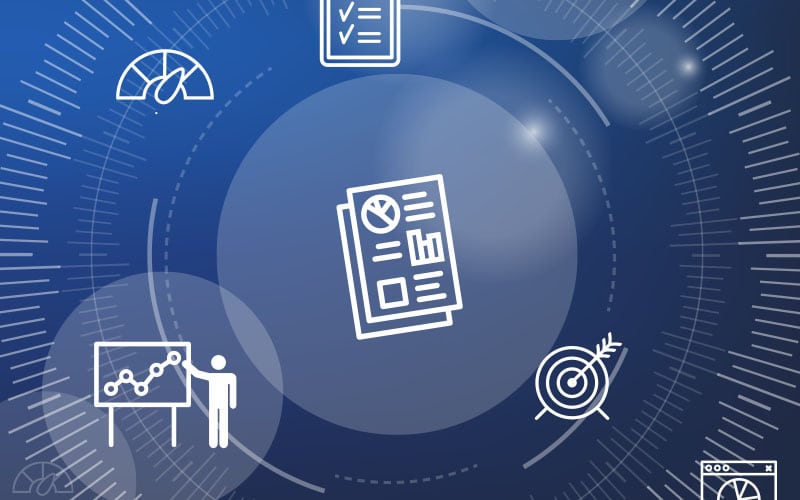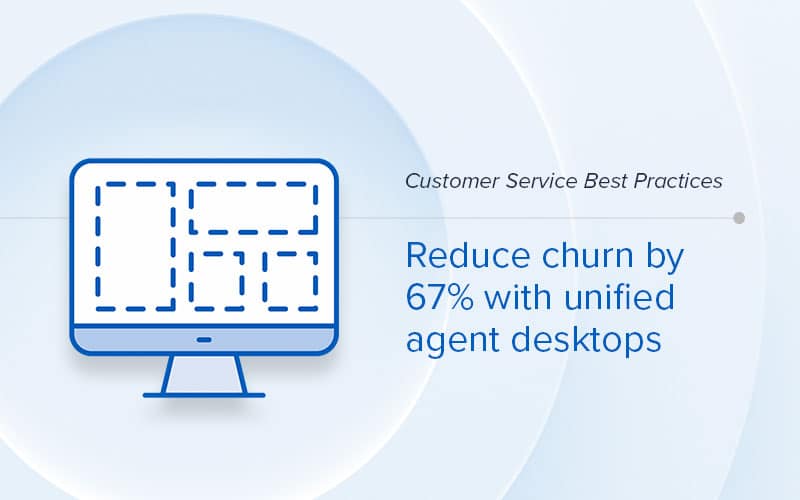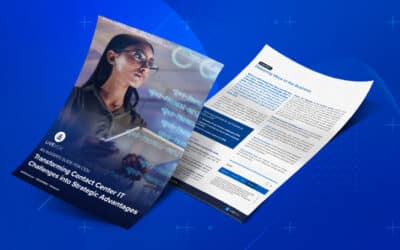Call center best practices revolve around improving customer service.
Table of contents
- What is contact center customer service?
- 1 in 3 customers will walk away after just one bad experience
- 60% of customers would like the option to use automated self-service
- 6 in 10 customers look to digital channels first for support
- 80% of customers respond positively when their customer experience is personalized
- Data-driven contact centers are 23 times more likely to gain new customers and 6 times more likely to retain them.
- 52% of customers think that companies need to take action on feedback from their customers.
- 62% of customers say that an agent’s knowledge and resourcefulness are key.
- Improved resolution time
- Streamlined service
- Call center customer service tips
Customer service is a defining factor in a company’s profitability and longevity, and it lies in the hands of its support reps, also called agents. Yet despite having such an important job, most call center agents will never meet the customers they’re working with face to face. So, having well-thought-out call center best practices is paramount to ensure an excellent customer experience.
Though call center agents don’t have the advantage of being able to give customers a firm handshake or a warm smile, they do have a variety of customer service channels at their disposal. They can leverage voice, email, SMS, chat and social media to make a good impression and provide a positive resolution. They can also use automated tools like virtual agents and interactive voice response (IVR) to supplement their efforts. These strategies and more can be deployed in the contact center to deliver consistently great customer service.
What is contact center customer service?
Using a data-driven approach to develop your CX best practices ensures you’re both being practical and working from the customer’s biggest needs as you craft your support strategy.
Consider these 9 CX best practices rooted in data as you develop your inbound support systems.
1 in 3 customers will walk away after just one bad experience
Losing one-third of your customers to bad CX is absolutely preventable. Design your CX strategy based on data to create a holistic customer experience. Use a unified CRM to view many interactions across channels to pinpoint areas across the customer journey for improvement.
Information like customer history, past interactions and tickets available across channels and in one threaded view let agents understand the needs of your customers and plan to meet or exceed them. Help your agents come into every conversation fully equipped to make sure your customers have a positive customer experience.

60% of customers would like the option to use automated self-service
Customers already use self-service options every day at the gas station and ATM. This option is becoming more common and will continue to do so post-Covid. By using call qualifications, routing algorithms, and contextual data, robust IVRs increase customer experience by improving first call resolution rates. Webchat and virtual assistance are handy here, too.
6 in 10 customers look to digital channels first for support
There are more communication channels than ever. When customers reach out to you, give them the ability to choose the channel that’s most convenient.
Channel freedom has been shown to improve customer satisfaction. It’s that simple.
80% of customers respond positively when their customer experience is personalized
Contact centers have access to more data than ever before. Use that data to make every step of the way with your business tailored to the customer.
Many customers say they prefer to interact with human agents because it feels more personal. But, human agents can be just as robotic as virtual agents. Each conversation you have should consider data points about your customers. Address your customers by name and incorporate past interactions to add a personal touch.
Data-driven contact centers are 23 times more likely to gain new customers and 6 times more likely to retain them.
Refine your service process by utilizing the greatest feedback generator available to you: your customers. CSAT surveys are incredibly helpful to find out what is and isn’t working.
52% of customers think that companies need to take action on feedback from their customers.
Unfiltered feedback from your customers is positive even when it is negative. Gathering feedback leads to actionable insight. With this insight you can create processes to measure and improve everything from customer experience to call workflows, routing, agent handle time— the possibilities are countless.
62% of customers say that an agent’s knowledge and resourcefulness are key.
When planning your customer experience strategy make sure agent knowledge is a core component. Customers want to feel like they are in good hands during any interaction with your company. Customer-facing liaisons are no different.
Make it easy for agents to have all of the knowledge they need to make customer interactions as smooth as possible by putting it in an easy to interact with configurable agent desktop.
Configurable agent desktops give you the right information when you need it. Agents no longer need to toggle through clunky windows. They have information and context in one window. It is an easy way to improve both agent and customer experience.

- 67% of customer attrition could be avoided if customer’s issues are resolved the first time around
What if you could guess with incredible accuracy what your customers needed before they asked you for it? Most people would say the idea sounds like science fiction. But the reality is, we’re not too far off.
Contact centers can now use artificial intelligence and machine learning to make the most of their CRMs. Optimal times for outreach can be pinpointed with the use of data.
Complex computations can be carried out to accurately predict your customer’s future needs. Leverage CRM to create customer experiences specific to each customer. Intuition is no longer specifically human and thank goodness. While human intuition remains a stalwart in the customer service journey, using artificial intelligence to analyze customer data and enhance agent performance provides precise, calculated insights.
- Contact centers with both human and virtual agents have reported a 61% improvement in customer satisfaction
Using a blend of human and virtual agents is quickly becoming a hallmark of a customer-centric approach to support in the contact center. That’s because it delivers two net positives to the customer:
Improved resolution time
Virtual agents can complete rote information-gathering tasks quickly and efficiently. This gives your agents the time they need to focus on more creative tasks in the contact center. In this way, they are also coming into each conversation with the most knowledge possible.
Streamlined service
With intelligent routing, customers arrive at the right agent the first time. This communicates competence as well that you understand their time is valuable.
With these 9 best practices you can calculate and improve customer retention efforts and set realistic, attainable service expectations for agents. Data and feedback are the peanut butter and jelly of defining CX best practices. Used properly and continuously, they can help make sure your inbound service is as iconic as the sandwich itself.
Call center customer service tips
Follow these proven tips for providing customer service that goes above and beyond expectations.
Properly understand complaints
All too often, agents are so zeroed in on tackling the call and moving to the next one in the queue that they forget about the bigger picture–getting to the heart of the complaint. Clarifying the root of the customer complaint not only allows agents to route them to the best resource to solve it, but helps call center managers develop tools like self-service resources that will lead to an even better customer experience in the future.
Come from a place of positivity
Easier said than done when you’re staring down a long call queue and a rigorous set of benchmarks to meet. Arming your agents with the right technology, like a configurable desktop and unified CRM, makes it easier for them to focus on their work with a less-stressed demeanor.
Play the long game
A long-standing customer is much more profitable than a one-off. Think beyond the single interaction and leverage customer details, purchasing history, and previous support interactions to provide an experience that wows over the life of the customer relationship.







